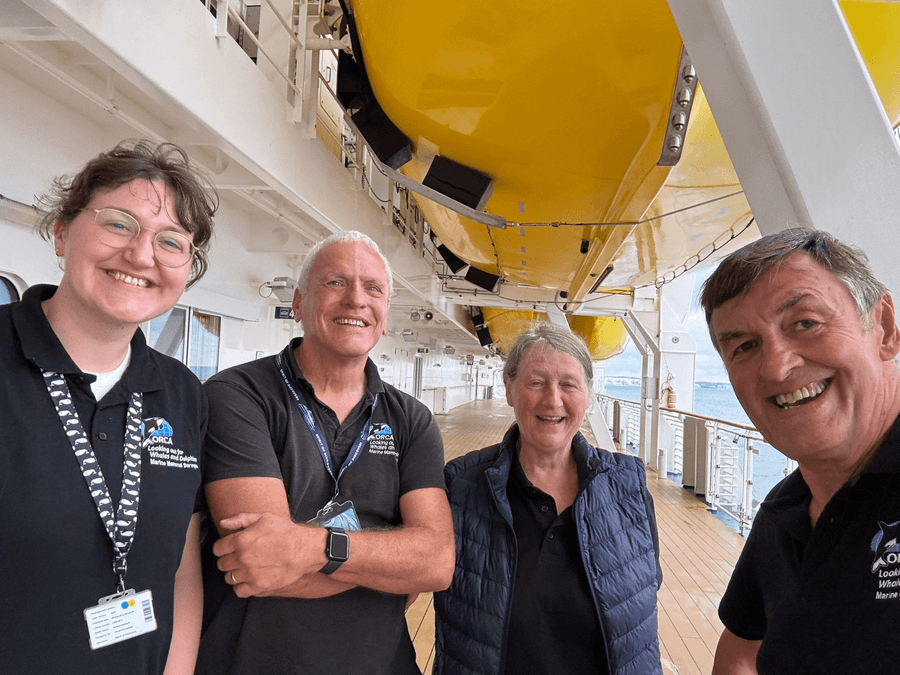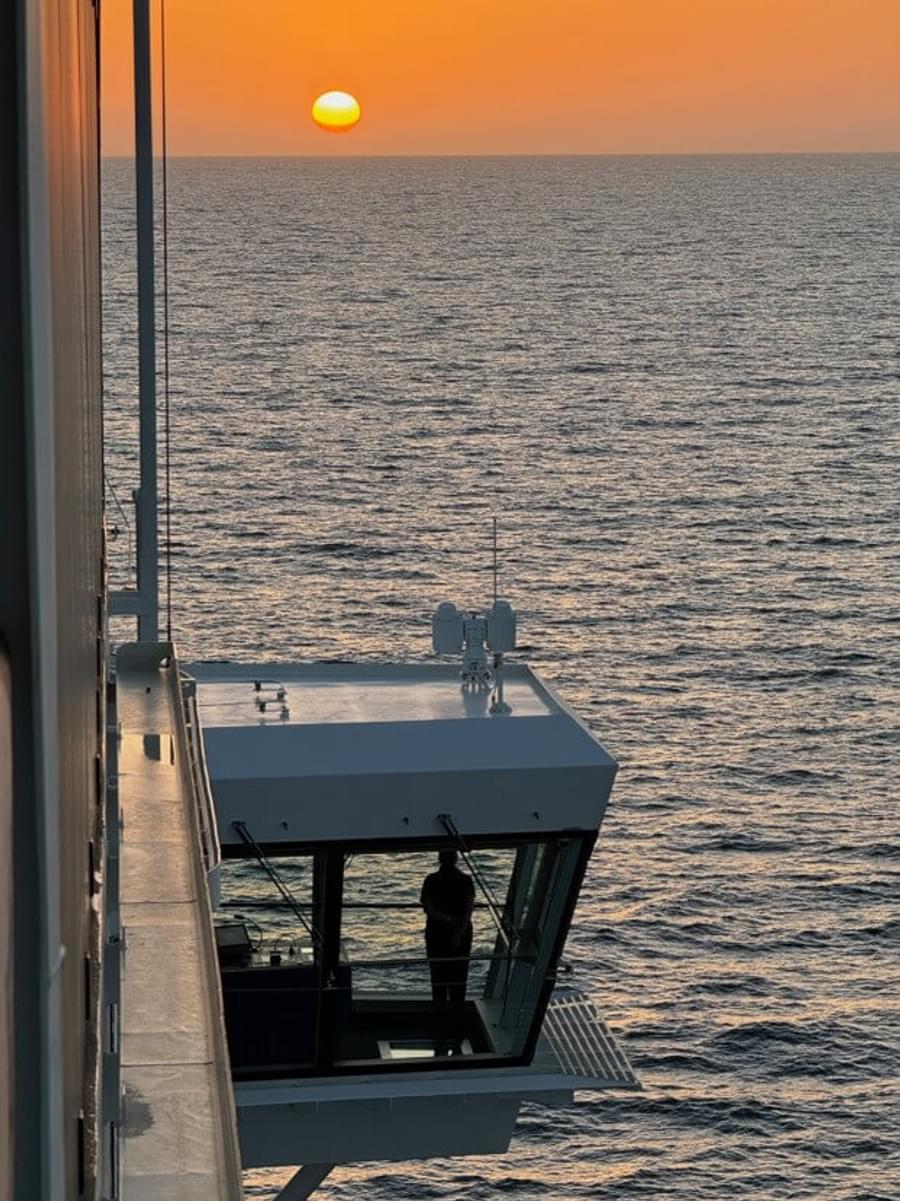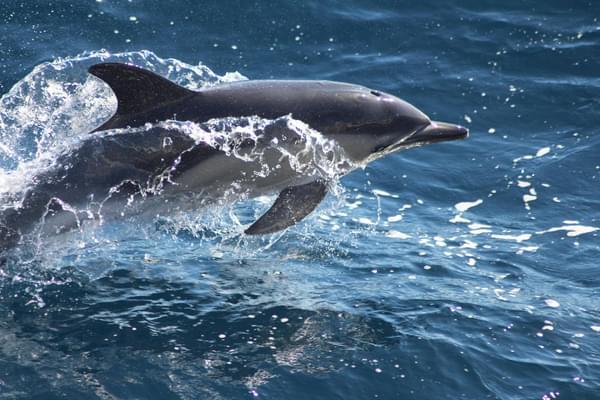Since 2007, teams of dedicated volunteer ORCA Marine Mammal Surveyors have been invited on board Saga cruise ships to provide guests with incredible wildlife experiences through delivering presentations, running deck-watches, and generally being on hand to talk about any wildlife seen on the trips. ORCA Marine Mammal Surveyors collect vital data on the whales and dolphins they see during these trips, whilst also being out on deck to help guests to spot and identify the marine life they are seeing for themselves.
In September, Penny, Terry, Jan and Richard joined guests on board Saga’s Spirit of Discovery for the Classical Greece and Ancient Egypt cruise - an incredible trip to the Mediterranean, with some fantastic cetacean sightings! The team share their experience on board:
Monday 9th September - Portsmouth
The ORCA team met at Dover and boarded the magnificent Spirit of Discovery. After settling into our cabins, we met for a stroll around the promenade deck, producing the first memorable sighting of the cruise, a convolvulus hawk moth, one of the UK’s largest insects, with a wing span of around 4 inches. The moth elected to stay at home, and flew from the ship while still in sight of Dover!

Tuesday 10th September – At sea
Our first day at sea, we had our first sightings of cetaceans; firstly the blow of a large whale, about 90 miles west of Brest, and a small pod of common dolphins. Seabirds were more numerous, with Manx, Great and Cory’s shearwaters all recorded. Terry gave the introductory talk in the morning, outlining the variety of different habitats sailed over on this cruise, and the cetacean species that we hoped to encounter.
Wednesday 11th September - At sea
Our second sea day was an overcast, squally day, with the team in their raincoats. Approaching the northwest coast of Spain, whale blows were noted. Shortly afterwards a whale surfaced just in front and to the port side of the bow. The whale immediately dived, and resurfaced shortly afterwards just off the port side, level with the front of deck 14, blew, a large blow, and dived again. The whale was at a right angle to the ship, so it wasn’t possible to see the shape of the fin, and it didn’t look as big as an adult fin whale. We debated whether it could be a young fin whale, or a sei whale, but it had to be recorded as unidentified…

Friday 13th September – Gibraltar
The team joined guests on an included excursion, a tour of the Rock! Back on board for sail away, with a good sized group of guests with us on deck 14, common dolphins were seen in the harbour area.
During the early evening, most of the team conducted surveying from the bridge, but Richard stayed out on deck 14 with guests. Surveying from the bridge is a new development in ORCA and Saga’s ongoing relationship. Surveying from the bridge and adhering to a strict surveying methodology (different to our flexible surveying out on deck, whilst also speaking to guests) enables us to collect the best quality data in the most important areas for cetaceans, following the same protocol that is employed on the ferries that ORCA partners with.
Our relationship with our Saga guests is of paramount importance though, so one member of the team will always remain on deck 14. We recorded 147 dolphins during that survey, a mix of common and striped dolphins. We knew that many of those dolphins wouldn't have been visible from deck 14, which proved to be the case as Richard saw only 16 of them, emphasising again the benefit of being able to survey from the bridge.
Saturday 14th September – At sea
Another day at sea, the team had to survey from deck 10 at the rear as deck 14 had been closed because of the weather. We saw a flying fish, numerous Scopoli’s shearwaters and a small pod of dolphins that morning. We were able to return to deck 14 later in the afternoon, and there were 3 more sightings of flying fish, and our first turtle.
Of the 7 species of sea turtles, 2 breed in the Mediterranean; loggerhead and green turtles, loggerheads being by far the most numerous. Studies have shown that loggerheads recorded in the most western parts of the Mediterranean, generally young males, originate from the Caribbean and return there to breed.

Sunday 15th September – At sea
Another day at sea, and no cetaceans recorded. Lots of Scopoli’s shearwaters, 2 flying fish and 2 turtles. We conducted our second bridge survey, this time leaving Terry on deck 14. There were no sightings at all recorded during that survey; disappointing but such a survey is every bit as important as those when animals are seen.
Monday 16th September - Syracuse, Sicily
A bridge survey from dawn until docking in Syracuse, with Richard manning deck 14. We recorded 5 dolphins, tuna and a lot of flying fish, once more than 30 in the air together!

Tuesday 17th September - At sea
Another sea day, and another day with no cetaceans seen. The team did see flying fish, and birds including yellow wagtail and turtle dove on board, and hoopoe, little egrets and grey heron flying past, well out of sight of any land.
Wednesday 18th September - Souda, Crete
There was no opportunity to survey today, but the team enjoyed exploring, and spotted sponges for sale. Sponges are classified as stationary animals. Approximately 700 species can be found in the Mediterranean. They are characterised by a high level of endemism, that is to say being restricted to a particular area, which of course make them vulnerable should the environment in their limited range be damaged. There has been a serious decline in their numbers, mainly attributable to epidemic disease and over harvesting..
Sunday 22nd September - At sea and Alexandria, Egypt
At sea, en route to Alexandria, where we docked at 5 in the afternoon. Although we recorded no cetaceans there was plenty of interesting wildlife to see. Large numbers of flying fish, reminiscent of tropical waters, with big shoals flying away from the bow.
Monday 23rd September - Alexandria, Egypt
Ashore in Egypt, and on our third continent of the cruise!
Whilst enjoying an excursion, we spotted hoopoes, there were at least 5!

Tuesday 24th September - At sea
At sea, and our only traverse of the Hellenic Trench in daylight. The Hellenic Trench has been designated an Important Marine Mammal Area. It is an oceanic trough, and the Calypso Deep, which lies within the Hellenic trench, is the deepest point in the Mediterranean, with a maximum depth of approximately 5,200 meters. The trench is home to the Endangered Mediterranean sperm whale subpopulation (200-250 individual whales). Cuvier’s beaked whales are more often seen here than elsewhere in the Mediterranean. So hopes were high! We had urged our interested guests to join us, and Richard estimated the time that we should sail over the beginning of the trench as about noon.
At 11.55 a large sperm whale surfaced ahead of the bow on the starboard side!
The whale remained at the surface, blowing repeatedly, until we had passed and it slipped away out of sight astern. We believe that this was a male sperm whale, they are about 40% bigger than females.
There is a large (healed) scar on the whale’s back. This is likely to be the result of an injury caused by a vessel strike, a perennial risk for animals inhabiting waters that are so busy with shipping.
Later in the afternoon another whale surfaced very briefly on the starboard side of the ship, diving again immediately, the view was very brief, but it was most likely a Cuvier’s beaked whale.

Sunday 29th September - At sea
Our sightings today were quality over quantity! Our only sighting of Risso’s dolphins during the cruise was a pod of 7 that came close to the ship.
We also had two sightings of turtles, both of which we believe were loggerheads.
We also saw flying fish, Scopoli’s shearwaters, and a flock of 91 cattle Egrets heading towards Africa.


Monday 30th September - At sea
The Alboran Sea, another important area of the Mediterranean for cetaceans. Unfortunately it seems no-one had told the whales! We saw no fins at all during the day, in fact all that we recorded was one flying fish! In the evening we conducted a two hour survey from the bridge, and recorded 6 dolphins. They were either common or striped dolphins, but not seen well enough to have been able to positively identify which. Richard, manning deck 14, recorded a striped and two common dolphins during the same period..
There was a variety of birds and insects on the ship though, with robin, blackcap, turtle dove, yellow wagtail, red-veined darter and emperor dragonflies, red admiral butterfly, and plain tiger, rush veneer and hummingbird hawk moths all recorded.
Tuesday 1st October - Ceuta
A reminder of a darker past. Between the 1920s and 1950s there was intensive whaling in the straits of Gibraltar. There were two whaling factories, either side of Ceuta, Beliones in the west in Morocco, and Getares. Within 5 years of the opening of Getares the region’s fin whales had been wiped out. The combination of whaling and fishing also caused a drastic reduction in numbers of other cetaceans and of turtles. There has been some recovery in numbers since whaling stopped in the 1950s. All cetacean and sea turtle species are now protected.
As we sailed away we were able to share views of striped dolphins, and some distant tuna, with a sizeable group of guests on deck 14.
Another bridge survey in the evening until dusk, with 11 dolphins recorded, which were either striped or common dolphins.
Wednesday 2nd October - At sea
Sea days now until Portsmouth. We conducted two bridge surveys, in the morning we recorded a pod of 17 striped dolphins, with at least one calf, and in the afternoon 21 common dolphins, 2 striped dolphins, a fin whale and the blows of two other whales that it wasn’t possible to identify.
Terry hosted a wildlife clinic in the Britannia lounge, an informal chat with several guests about their photographs, sightings and so on.


Thursday 3rd October
More sightings of both common and striped dolphins, with at least one striped dolphin calf. The common dolphins were under a flock of about 20 Cory’s shearwaters.
In the afternoon a 3 hour bridge survey, with just one blow from an unidentified whale recorded.
Friday 4th October
Our final day at sea, and a busy one!
In the morning a 2 hour bridge survey during which we recorded 24 sightings, comprising totals of 72 common dolphins, 67 striped dolphins and 5 unidentified dolphins. We finished the survey at noon, coinciding with Captain Volaric’s address, and were able to thank him personally for his hospitality, and talk to him about what we had seen, particularly during the bridge surveys.
As that was to be the last survey of the cruise, we were able to calculate and summarise our activity. We had surveyed on deck for 123 hours, over a distance of 3,352 kilometres, during which we recorded 195 common dolphins, 191 striped dolphins, 7 Risso’s dolphins, 51 unidentified dolphins, I sperm whale, I fin whale, 9 unidentified whales, 2 unidentified beaked whales, 5 turtles, a sunfish and 6 tuna, a total of 470 animals. In addition we surveyed from the bridge for 18 hours and 51 minutes, over a distance of 524 kilometres, recording 131 common dolphins, 154 striped dolphins, 32 unidentified dolphins and 6 unidentified whales.
Immediately following the survey Penny was the quiz master for the ever popular ORCA quiz. Our wildlife round up talk was scheduled for later in the afternoon, Terry and Richard shared the presentation.
And that marked the end of another wonderful cruise on board the Spirit of Discovery, our thanks to Saga!



The only way we can protect whales and dolphins is by understanding their distribution, and so monitoring is vital for effective conservation - this is where our Marine Mammal Surveyors come in...
We've now announced all of our 2025 Marine Mammal Surveyor courses. Book today by visiting www.orca.org.uk/train!

